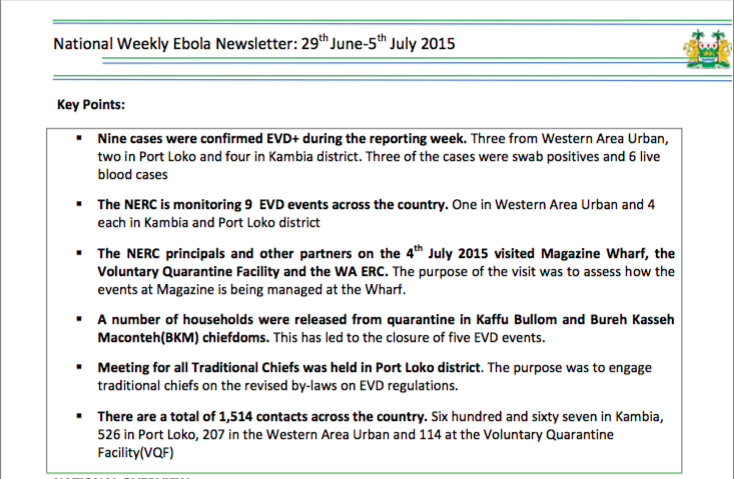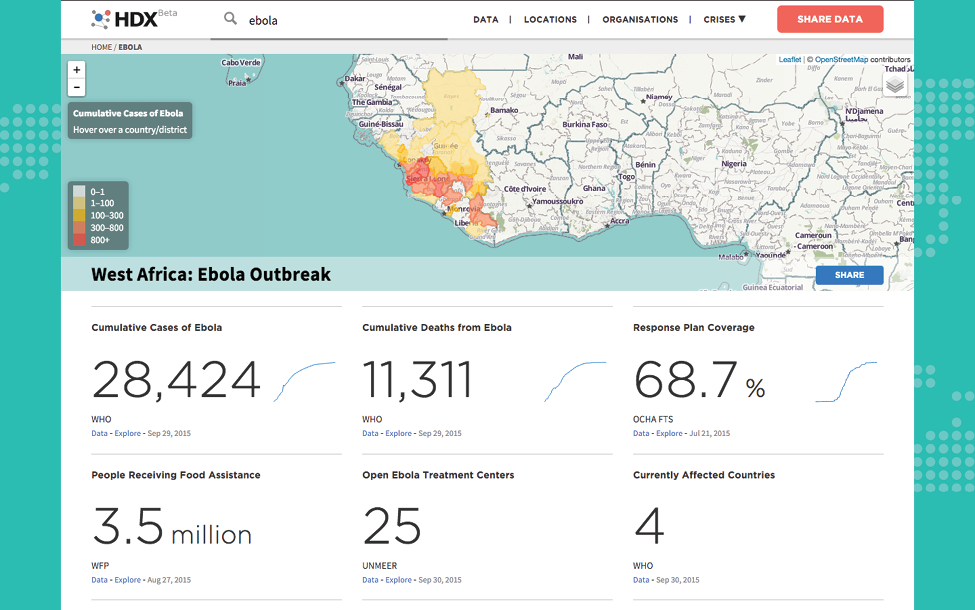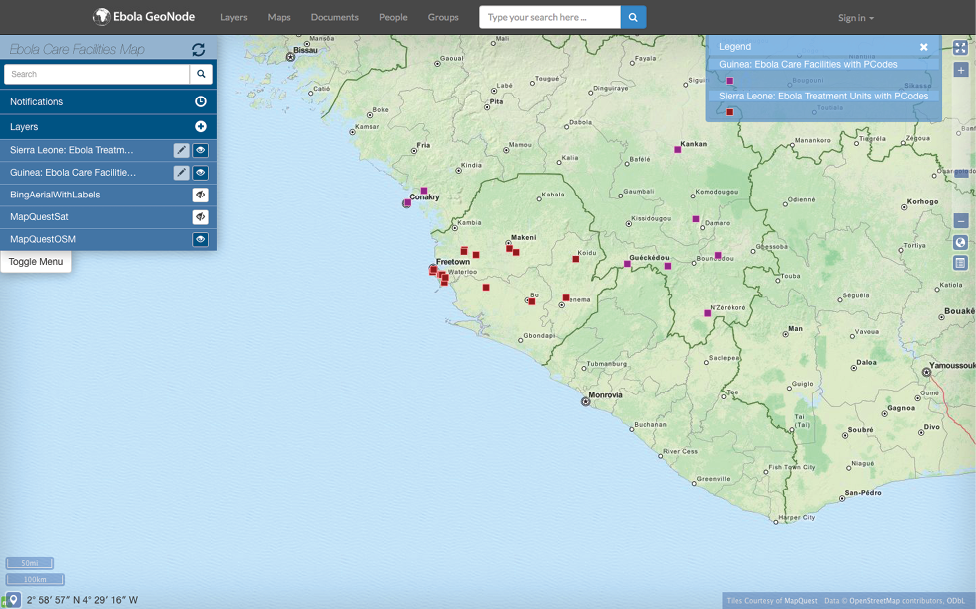The Global Impact of Open Data
Battling Ebola in Sierra Leone
Data Sharing to Improve Crisis Response
by Andrew Young and Stefaan Verhulst*
Reference
1 Special thanks to Akash Kapur who provided crucial editorial support for this case study, and to the peer reviewers [odimpact.org/about] who provided input on a pre-published draft.
2 Abdulai, Saffa. “Connecting Open Data and the Right to Information in Sierra Leone.” Open Data Research Network. http://www.opendataresearch.org/content/2014/642/connecting-open-data-and-right-information-sierra-leone
4 http://www.opengovpartnership.org/sites/default/files/SIERRA%20LEONE_FINAL%20NATIONAL%20ACTION%20PLAN_6_15_2014_Final.pdf
7 “Ebola virus disease – Fact Sheet.” World Health Organization. Updated January 2016. http://www.who.int/mediacentre/factsheets/fs103/en/
8 “Ebola (Ebola Virus Disease) – Signs and Symptoms.” Centers for Disease Control and Prevention. http://www.cdc.gov/vhf/ebola/symptoms/
9 “Ebola (Ebola Virus Disease) – Outbreaks.” Centers for Disease Control and Prevention. http://www.cdc.gov/vhf/ebola/outbreaks/
10 “Ebola (Ebola Virus Disease) – Outbreaks Chronology: Ebola Virus Disease.” Centers for Disease Control and Prevention. http://www.cdc.gov/vhf/ebola/outbreaks/history/chronology.html
11 Garrett, Laurie. “Ebola’s Lessons: How the WHO Mishandled the Crisis.” Foreign Affairs. September/October 2015. https://www.foreignaffairs.com/articles/west-africa/2015-08-18/ebolas-lessons
12 United Nations Security Council Resolution 2177 (2014). http://www.ifrc.org/docs/IDRL/UN%20SC%20Res.pdf
13 Spooner, Samantha. “Ebola could kill 100,000 and needs $1 billion to defeat, but Nigeria shows the world how it’s done.” Mail & Guardian Africa. September 21, 2014. http://mgafrica.com/article/2014-09-19-as-the-war-against-ebola-rages-nigeria-shows-the-world-how-its-done
14 Garrett, Laurie. “Ebola’s Lessons: How the WHO Mishandled the Crisis.” Foreign Affairs. September/October 2015. https://www.foreignaffairs.com/articles/west-africa/2015-08-18/ebolas-lessons
15 “UNMEER-WHO Transition Message.” World Health Organization Regional Office for Africa. http://www.afro.who.int/en/sierra-leone/press-materials/item/7897-unmeer-who-transition-message.html
16 Westcott, Lucy. “Q&A with Anthony Banbury: UN’s Ebola Mission Can Still Do More.” Newsweek. November 24, 2014. http://www.newsweek.com/qa-anthony-banbury-uns-ebola-mission-can-still-do-more-286724
17 Maxmen, Amy. “How Ebola Found Fertile Ground in Sierra Leone’s Chaotic Capital.” National Geographic. January 27, 2015. http://news.nationalgeographic.com/news/2015/01/150127-ebola-virus-outbreak-epidemic-sierra-leone-freetown-photos-pictures/
18 Maxmen, Amy. “How Ebola Found Fertile Ground in Sierra Leone’s Chaotic Capital.” National Geographic. January 27, 2015. http://news.nationalgeographic.com/news/2015/01/150127-ebola-virus-outbreak-epidemic-sierra-leone-freetown-photos-pictures/
19 Simons, Rupert. “Inside the National Ebola Response Centre.” Africa Governance Initiative. October 17, 2014. http://www.africagovernance.org/article/inside-national-ebola-response-centre
20 GovLab interview with Rupert Simons, Former Advisor to the African Governance Initiative; CEO Publish What You Fund, August 6, 2015.
21 Example brief: http://nerc.sl/sites/default/files/docs/20151126_Nerc_Eve_Brief%20Count%20Down.pptx%201.pdf
22 GovLab interview with Rupert Simons, Former Advisor to the African Governance Initiative; CEO Publish What You Fund, August 6, 2015.
23 Example newsletter: http://199.230.52.230/sites/default/files/docs/National%20%20Ebola%20Response%20%20Centre%20--%20Weekly%20%20%20Newsletter%20%2029th%20June%20-5th%20July%202015%20%282%29.pdf
24 “Humanitarian Data: OCHA launches ground-breaking data exchange platform.” United Nations Office for the Coordination of Humanitarian Affairs. July 15, 2014. http://www.unocha.org/top-stories/all-stories/humanitarian-data-ocha-launches-ground-breaking-data-exchange-platform
25 Griliopoulos, Dan. “Data exchange helps humanitarians act fast and effectively.” The Guardian. December 29, 2014. http://www.theguardian.com/global-development/2014/dec/29/humanitarian-data-exchange-ebola-refugees
26 Griliopoulos, Dan. “Data exchange helps humanitarians act fast and effectively.” The Guardian. December 29, 2014. http://www.theguardian.com/global-development/2014/dec/29/humanitarian-data-exchange-ebola-refugees
27 GovLab interview with Javier Teran, Statistician, United Nations Office for the Coordination of Humanitarian Affairs, Humanitarian Data Exchange, September 18, 2015.
28 GovLab interview with Javier Teran, Statistician, United Nations Office for the Coordination of Humanitarian Affairs, Humanitarian Data Exchange, September 18, 2015.
29 GovLab interview with Javier Teran, Statistician, United Nations Office for the Coordination of Humanitarian Affairs, Humanitarian Data Exchange, September 18, 2015.
30 GovLab interview with Javier Teran, Statistician, United Nations Office for the Coordination of Humanitarian Affairs, Humanitarian Data Exchange, September 18, 2015.
31 GovLab interview with Javier Teran, Statistician, United Nations Office for the Coordination of Humanitarian Affairs, Humanitarian Data Exchange, September 18, 2015.
33 GovLab interview with Javier Teran, Statistician, United Nations Office for the Coordination of Humanitarian Affairs, Humanitarian Data Exchange, September 18, 2015.
34 GovLab interview with Javier Teran, Statistician, United Nations Office for the Coordination of Humanitarian Affairs, Humanitarian Data Exchange, September 18, 2015.
35 GovLab interview with Javier Teran, Statistician, United Nations Office for the Coordination of Humanitarian Affairs, Humanitarian Data Exchange, September 18, 2015.
36 GovLab interview with Javier Teran, Statistician, United Nations Office for the Coordination of Humanitarian Affairs, Humanitarian Data Exchange, September 18, 2015.
37 GovLab interview with Javier Teran, Statistician, United Nations Office for the Coordination of Humanitarian Affairs, Humanitarian Data Exchange, September 18, 2015.
38 GovLab interview with Patrick Dufour, Former Senior Web GIS Developer, U.S. Department of State, Humanitarian Information Unit, December 17, 2015.
39 GovLab interview with Patrick Dufour, Former Senior Web GIS Developer, U.S. Department of State, Humanitarian Information Unit, December 17, 2015.
41 http://ebolageonode.org/maps/#?limit=100&offset=0
45 GovLab interview with Vivien Deparday, Disaster Risk Management Specialist, Open Data for Resilience Initiative Operational Deployment Lead, Global Facility for Disaster Risk and Reduction, World Bank, December 17, 2015.
46 GovLab interview with Vivien Deparday, Disaster Risk Management Specialist, Open Data for Resilience Initiative Operational Deployment Lead, Global Facility for Disaster Risk and Reduction, World Bank, December 17, 2015.
47 GovLab interview with Rupert Simons, Former Advisor to the African Governance Initiative; CEO Publish What You Fund, August 6, 2015.
48 GovLab interview with Javier Teran, Statistician, United Nations Office for the Coordination of Humanitarian Affairs, Humanitarian Data Exchange, September 18, 2015.
49 GovLab interview with Rupert Simons, Former Advisor to the African Governance Initiative; CEO Publish What You Fund, August 6, 2015.
50 Simons, Rupert. “Inside the National Ebola Response Centre.” Africa Governance Initiative. October 17, 2014. http://www.africagovernance.org/article/inside-national-ebola-response-centre
51 GovLab interview with Patrick Dufour, Former Senior Web GIS Developer, U.S. Department of State, Humanitarian Information Unit, December 17, 2015.
52 Cassano, Jay. “Inside the Crowdsourced Map Project That Is Helping Contain the Ebola Epidemic.” Fast Company. October 22, 2014. http://www.fastcolabs.com/3037350/elasticity/inside-the-crowdsourced-map-project-that-is-helping-contain-the-ebola-epidemic
53 GovLab interview with Rupert Simons, Former Advisor to the African Governance Initiative; CEO Publish What You Fund, August 6, 2015.
54 GovLab interview with Patrick Dufour, Former Senior Web GIS Developer, U.S. Department of State, Humanitarian Information Unit, December 17, 2015.
55 GovLab interview with Javier Teran, Statistician, United Nations Office for the Coordination of Humanitarian Affairs, Humanitarian Data Exchange, September 18, 2015.
56 GovLab interview with Patrick Dufour, Former Senior Web GIS Developer, U.S. Department of State, Humanitarian Information Unit, December 17, 2015.
57 GovLab interview with Vivien Deparday, Disaster Risk Management Specialist, Open Data for Resilience Initiative Operational Deployment Lead, Global Facility for Disaster Risk and Reduction, World Bank, December 17, 2015.
58 GovLab interview with Patrick Dufour, Former Senior Web GIS Developer, U.S. Department of State, Humanitarian Information Unit, December 17, 2015.
59 GovLab interview with Javier Teran, Statistician, United Nations Office for the Coordination of Humanitarian Affairs, Humanitarian Data Exchange, September 18, 2015.
60 GovLab interview with Patrick Dufour, Former Senior Web GIS Developer, U.S. Department of State, Humanitarian Information Unit, December 17, 2015.
61 GovLab interview with Javier Teran, Statistician, United Nations Office for the Coordination of Humanitarian Affairs, Humanitarian Data Exchange, September 18, 2015.
62 GovLab interview with Javier Teran, Statistician, United Nations Office for the Coordination of Humanitarian Affairs, Humanitarian Data Exchange, September 18, 2015.
63 GovLab interview with Javier Teran, Statistician, United Nations Office for the Coordination of Humanitarian Affairs, Humanitarian Data Exchange, September 18, 2015.
64 GovLab interview with Rupert Simons, Former Advisor to the African Governance Initiative; CEO Publish What You Fund, August 6, 2015.
65 GovLab interview with Rupert Simons, Former Advisor to the African Governance Initiative; CEO Publish What You Fund, August 6, 2015.
66 GovLab interview with Javier Teran, Statistician, United Nations Office for the Coordination of Humanitarian Affairs, Humanitarian Data Exchange, September 18, 2015.
67 GovLab interview with Javier Teran, Statistician, United Nations Office for the Coordination of Humanitarian Affairs, Humanitarian Data Exchange, September 18, 2015.
68 GovLab interview with Patrick Dufour, Former Senior Web GIS Developer, U.S. Department of State, Humanitarian Information Unit, December 17, 2015.
69 GovLab interview with Patrick Dufour, Former Senior Web GIS Developer, U.S. Department of State, Humanitarian Information Unit, December 17, 2015.
70 GovLab interview with Vivien Deparday, Disaster Risk Management Specialist, Open Data for Resilience Initiative Operational Deployment Lead, Global Facility for Disaster Risk and Reduction, World Bank, December 17, 2015.
71 “Report of the Ebola Interim Assessment Panel.” World Health Organization. May 2015. http://www.who.int/entity/csr/resources/publications/ebola/report-by-panel.pdf?ua=1
72 GovLab interview with Javier Teran, Statistician, United Nations Office for the Coordination of Humanitarian Affairs, Humanitarian Data Exchange, September 18, 2015.
73 GovLab interview with Javier Teran, Statistician, United Nations Office for the Coordination of Humanitarian Affairs, Humanitarian Data Exchange, September 18, 2015.
75 GovLab interview with Javier Teran, Statistician, United Nations Office for the Coordination of Humanitarian Affairs, Humanitarian Data Exchange, September 18, 2015.
76 GovLab interview with Javier Teran, Statistician, United Nations Office for the Coordination of Humanitarian Affairs, Humanitarian Data Exchange, September 18, 2015.
77 GovLab interview with Vivien Deparday, Disaster Risk Management Specialist, Open Data for Resilience Initiative Operational Deployment Lead, Global Facility for Disaster Risk and Reduction, World Bank, December 17, 2015.
78 GovLab interview with Vivien Deparday, Disaster Risk Management Specialist, Open Data for Resilience Initiative Operational Deployment Lead, Global Facility for Disaster Risk and Reduction, World Bank, December 17, 2015.
79 GovLab interview with Vivien Deparday, Disaster Risk Management Specialist, Open Data for Resilience Initiative Operational Deployment Lead, Global Facility for Disaster Risk and Reduction, World Bank, December 17, 2015.
80 Quinn, Kristin. “An Unprecedented Response: The GEOINT Community’s Role in the Ebola Relief Effort.” Trajectory Magazine. 2015. http://trajectorymagazine.com/government/item/1908-an-unprecedented-response.html
81 GovLab interview with Vivien Deparday, Disaster Risk Management Specialist, Open Data for Resilience Initiative Operational Deployment Lead, Global Facility for Disaster Risk and Reduction, World Bank, December 17, 2015.
82 O’Carroll, Lisa and Umaru Fofana. “WHO officially declares Sierra Leone Ebola-free.” The Guardian. November 7, 2015. http://www.theguardian.com/world/2015/nov/07/world-health-organisation-sierra-leone-ebola-free
83 “Sierra Leone dissolves Ebola response centre.” The Citizen. January 6, 2016. http://www.thecitizen.co.tz/News/Sierra-Leone-dissolves-Ebola-response-center/-/1840340/3022944/-/11h8g99z/-/index.html
84 “Sierra Leone dissolves Ebola response centre.” The Citizen. January 6, 2016. http://www.thecitizen.co.tz/News/Sierra-Leone-dissolves-Ebola-response-center/-/1840340/3022944/-/11h8g99z/-/index.html
85 “Sierra Leone dissolves Ebola response centre.” The Citizen. January 6, 2016. http://www.thecitizen.co.tz/News/Sierra-Leone-dissolves-Ebola-response-center/-/1840340/3022944/-/11h8g99z/-/index.html
86 Searcey, Dionne and Sheri Fink. “Day After a Victory Over Ebola, Sierra Leone Reports a Death.” The New York Times. January 15, 2016.





